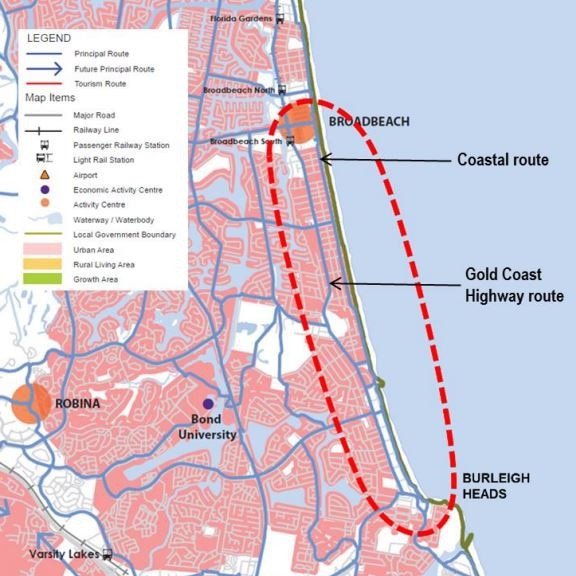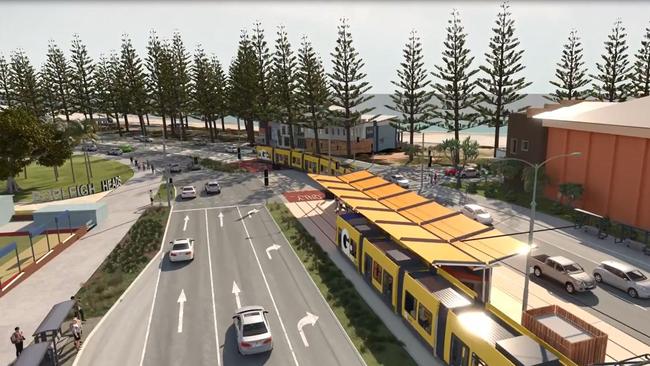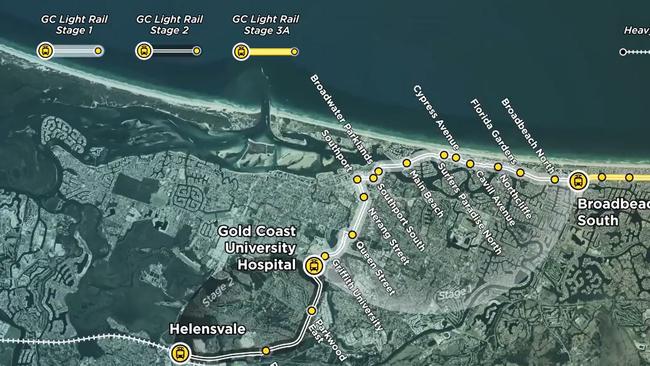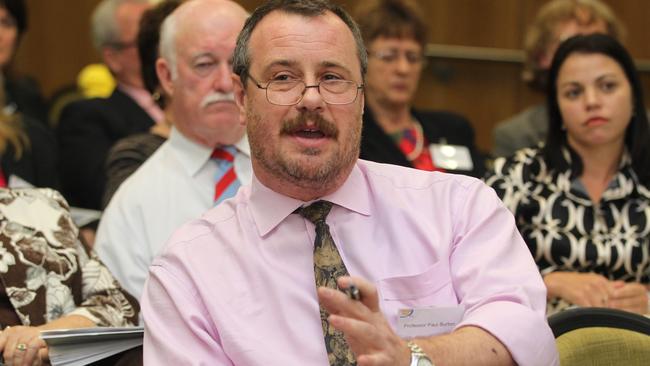Rate rise on the cards?: Fresh twist looms for Gold Coast suburbs in light rail debate
UPDATE: It’s one of the most polarising topics on the Gold Coast and there is set to be fresh debate as investigations look into who will pay for what in any light rail developments. SUBSCRIBE TO HAVE YOUR SAY
Gold Coast
Don't miss out on the headlines from Gold Coast. Followed categories will be added to My News.
LOVE it or loathe it, the light rail is on track to polarise opinions yet again.
With stage one of the project reportedly boosting the surrounding land value by a total of $300 million, future G:Link extensions are set to be a gravy train for nearby property owners.
But new research means they may well have to pay for the privilege.
RECENT HISTORY OF LIGHT RAIL DEBATE
‘Currumbin doesn’t want to go the same way as Palm Beach’
First designs revealed as route chosen for light rail to airport
First resumptions for light rail to Burleigh
‘Tram tax’ facing southern commuters slammed
Griffith University Professor of Urban Management and Planning and director of its Cities Research Institute Paul Burton says his department is investigating not just how the light rail adds value to land owners but if – and how – the beneficiaries should share the largesse with their neighbours.
While a targeted rate rise may sound alarm bells for residents, Paul says it’s all about being a team player. As a former town planner who now studies our city for the benefit of others, Paul says the Gold Coast can lead southeast Queensland out of its COVID-19 depression.

But he warns future success will require flexibility from both residents and leaders as well as a commitment to meet the challenge of change … starting with the light rail.
“The light rail has been a controversial project but one that I think inarguably can be said to be positive for the city,” says Paul.
“It’s a fantastic piece of infrastructure and if you live in the light rail corridor, the land values have gone up, or will go up.
REVEALED: The light rail planning underway in major Coast suburb
“What we’re doing is first of all trying to measure precisely how much the increase is, and how much of that can be attributed to the light rail. If you live within walking distance of a station then it’s definitely affected your property value because having public transportation links is a great selling point.
“If you live two to three kilometres away from a station, then it’s arguable how much light rail has added value to your home.
“Once we’ve solved that part of the equation, the question is looking at how we share that value across the city.

“If your home has rocketed in value because of infrastructure, then maybe you should be paying more back into the city so that infrastructure can be built in other areas. That might be through a simple rate rise for those living within a 500m radius of a station, for example.
“Just as we should compensate someone if we impinge on their property for the sake of a project that is for the common good, perhaps they should repay other residents if they stand to benefit from such a project. It’s the principal of compensation, but in reverse.
“But as you can imagine, regardless of the fairness of that idea, suggestions of increased rates and levies are inevitably met with opposition. We’re trying to find a way that’s palatable and that will see all of the city’s residents able to reap the benefits of a growing transportation network.”

Of course, as a trained town planner, Paul is used to copping criticism. Since moving to the Gold Coast from the UK in 2007 to take up a chair in Urban Planning and Management at Griffith University, he’s worked closely with the City of Gold Coast and says our city planners are “damned if they do, damned if they don’t”.
He says while Palm Beach remains ground zero in the battle for and against development, it’s a heated conversation that is ultimately healthy for our city.
In fact, he says what concerns him more are the sprawling suburbs in the city’s north.
“Town planners get blamed for what they do allow and what they don’t allow. But overall I think the city’s planners have got it about right. All planning schemes have to be constantly reviewed to make sure they are doing what they are intended to do. The town plan has to evolve with the city.
“People have a very polarised view of the Gold Coast. Many think the only options are a four-bedroom detached house in the ’burbs or a unit in the Q1. Those are actually the extremes, in between are so many possibilities.
“When we talk about higher density living along the coastal strip, that might mean four-storeys, not skyscrapers.
“The fact is that we can’t lock people off from the beach and send them to live in suburban isolation. Our biggest challenge over the next 50 years is ensuring that the Gold Coast is built not just for tourists but residents.
“We need to manage the growth so we don’t spoiled the environment, and part of that is keeping the footprint smaller and the density higher.
“I can live with high-rise shadows on the beach, what I don’t like is the sprawl of northern suburbs where not enough thought was put into how they would function.
“Each development in and of itself is fine. There are parks and the homes are nice and the streets are landscaped … but it’s just one after another after another and no thought into the fact they’re all trying to cram on to the M1 at the same time every morning.
“There is no character either.”
UPDATE:
Paul says closing the Coast to further growth is not an option, although he says rates may drop due to COVID effects. He says the city should prepare for more changes post-pandemic and embrace flexibility in planning and design.
He says the city has already lost some opportunities due to rigidity, an attitude that would only worsen the economic shockwaves from coronavirus.
“The future is certainly looking more uncertain than this time last year.
“There is the possibility that, post-COVID, people will be less likely to start a new life in a new place. Certainly our international migration will be affected. We really need to embrace any opportunities that provide growth, because the more people we have here the more dynamic our economy becomes.
MORE LIGHT RAIL NEWS
Green light for massive new tower development
$1m to build Coast cableway by 2023
First look: Palm Beach’s newest tower
“The idea of a population cap for the Coast is really just absurd. There’s no way to enforce it to begin with, and residents would ultimately be worse off if we were to shrink in size.
“The more business and industry that we can base here, the better. I think we need to reassess how we woo those businesses, however. Post-COVID, more people will continue working from home – which makes the Gold Coast more attractive as a base – and less will be based in big office towers in the CBD, of which we already have too many, especially in Southport.
“Now is a good time to rethink Southport, we could do with less towers and more organic space, and already there is lots of talk about opening the suburb up towards the Broadwater. If you could go back in time and get rid of Australia Fair that would be a start.
“We also need to accept that there are going to be a lot of empty storefronts across the city, and we need to welcome new and flexible ideas into these spaces, which is something we haven’t welcomed in the past.

“After the old hospital was knocked down in Southport, I suggested that we use that vacant land as a temporary park with pop-up shops in shipping containers and entertainment. It would only have been there for a few years but would have been better than a gaping hole.
“Instead, I was told that while the idea was fantastic, once it was time to build the apartments and grocery stores, people would complain about the loss. So they decided it was better to have a vacant lot than to ultimately get rid of something that people could have enjoyed for a few years.
“But these temporary-use ideas need to become a part of our landscape as we come out of COVID. We need to cut some of the red tape, not all of it – safety has to be paramount, to let ideas grow into success.”
Speaking of creative ideas, Paul says while Mayor Tom Tate’s suggestion that the NSW border should be moved further south to incorporate Tweed Heads into the Gold Coast is unlikely to occur, there is merit in the idea.
He says there is strength in numbers, something he is seeing emerge as the Gold Coast finds its place in the team of southeast Queensland.
“No one can deny that what happens in Tweed is inextricably linked to the Gold Coast. If you were starting from scratch now, there’s no way you would draw the border where it is.
“In practice, northern NSW has more in common with Brisbane than with Sydney. And I think many would prefer to be a part of Queensland, the NSW Government is not known for paying much attention to anywhere outside Sydney.
“When it comes to southeast Queensland, Brisbane is just one player and increasingly we’re all working together to make this region the most dynamic in Australia.
“The Olympic bid is just one example. Individually, we’re fantastic cities and towns. Together, we’re a powerhouse.”
Just as those Gold Coast residents most likely to benefit from the light rail can help the city as a whole, the Coast can lead the way forward for Team SEQ post-pandemic.
After all, when it comes to success, just look at our track record.



